Public comments are needed by October 16th. Please submit your public comment today!
The Department of Environmental Conservation (DEC) has finalized the Essex Chain Complex Final Unit Management Plan (ECCFUMP), which it completed after a public hearing and public comments in July 2015. This UMP widely violates state law, such as the Wild, Scenic and Recreational Rivers Act, and fails to comply with various requirements of the Adirondack Park State Land Master Plan (SLMP). The Adirondack Park Agency (APA) is now holding a public hearing on this deeply flawed and illegal plan. The APA is taking public comments until October 16, 2015.
The principal management objective for the Essex Chain Lakes Complex area should be forest restoration and natural resource preservation. These lands were intensively managed timberlands for more than 100 years and now must be ecologically restored.
The Adirondack Park is undergoing the greatest expansion of motorized recreational uses in the history of the “forever wild” Forest Preserve. With each new UMP or UMP Amendment, motorized uses are expanded primarily through creation of major new class II community connector snowmobile trails, which often necessitate the destructions of thousands of trees and vast terrain alterations with heavy machinery. These large road-like “trails” are unlike any other type of trail on the Forest Preserve in width and terrain changes. These trails are designed and built for high speed motorized uses, unlike any other Forest Preserve structure or improvement.
Click here for a copy of the DEC’s submission of the Essex Chain Complex Final UMP (note that it’s a large final and take a long time to download).
See the end of this post for information about where to send your letter to the APA or to send in an automatic letter.
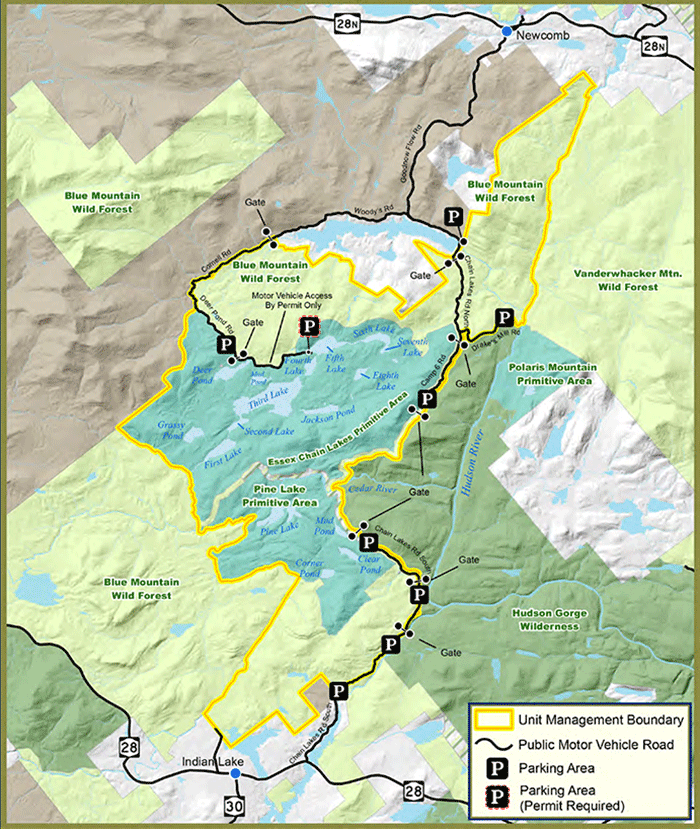
This map shows the boundaries of the Essex Chain Lakes Complex, a mixture of Forest Preserve lands classified as Primitive and Wild Forest. These lands were controversially classified in 2013 with expansive Wild Forest areas, including a motorized Wild Forest corridor through the heart of the area.
Violations of Wild, Scenic and Recreational Rivers Act and DEC Part 666 Rivers Act Regulations
The ECCFUMP is stunning in its blatant disregard for both the NYS Wild, Scenic and Recreational Rivers Act and DEC’s Part 666 Rivers Act regulations. The ECCFUMP should comply with the Wild, Scenic and Recreational Rivers Act, which prohibits a motor vehicle bridge over the Cedar River, prohibits retention of the Polaris Bridge for use by motor vehicles, and prohibits motor vehicles such as float planes on Pine Lake or automobiles on the Chain Lake Road South within the .5-mile corridor of classified as Wild rivers. The APA should require compliance with the Rivers Act by the DEC in this UMP.
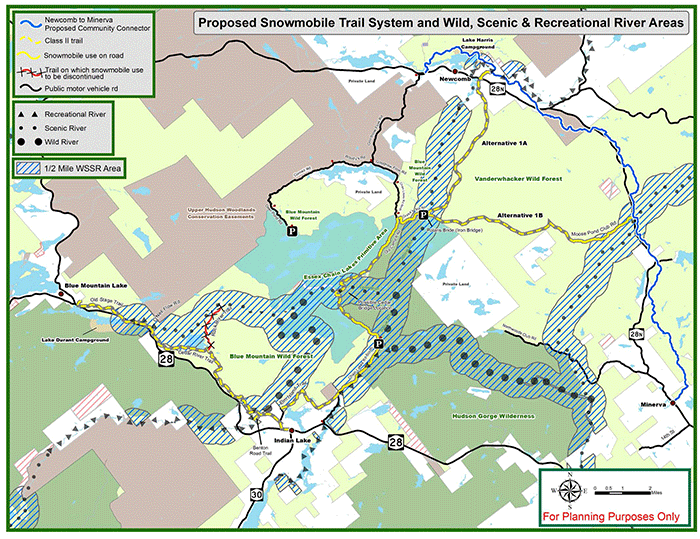
This map highlights the Wild, Scenic and Recreational River corridors within the Essex Chain Lakes Complex area. It’s clear that the proposed new bridge over the Cedar River, Chain Lakes Road South, Polaris Bridge and Pine Lake are all located within a classified river corridor under the Rivers Act. It’s important that the Rivers Act be upheld and these wild and scenic rivers protected.
Proposed Cedar River Bridge Violates Rivers Act: The plan’s proposal to construct a new bridge over the Cedar River where it is classified as a Scenic River is a serious violation of the Rivers Act. DEC’s argument that somehow private leaseholder rights constitute an interest that supersede or is exempted from the protections of the Rivers Act is without merit. This is simply a baseless claim. There is no legal way that a new motor vehicle bridge over the Cedar River is allowable. Further, the Rivers Act and the SLMP prohibit expansion or alteration of existing uses.
Proposed Retention of Polaris Bridge Violates the Rivers Act: The plan also propose to retain the Polaris Bridge over the Hudson River where it is classified as a Scenic River. Like the proposed Cedar River Bridge, this proposal to retain the Polaris Bridge also violates the Rivers Act. DEC makes many of the same baseless arguments advanced for construction of a new Cedar River Bridge, regarding grandfathering of private leaseholder rights, to support its proposal to retain the Polaris Bridge for motor vehicles. Again, these are simply baseless claims. There is simply no legal way to retain the Polaris Bridge over the Hudson River for use by motor vehicles.
PROTECT opposes retention of the Polaris Bridge and has called for it to be removed and the river area to be restored. The Hudson River at this point is a marvelous flatwater area know as the Blackwell Stillwater. The Goodnow River also enters the Hudson at this point and provides great canoeing opportunities on a classic meandering Adirondack River.
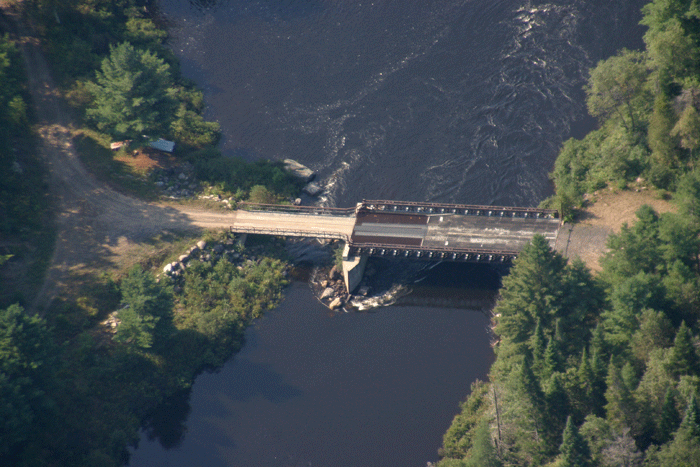
DEC proposes to keep the Polaris bridge. PROTECT believes this violates the Wild, Scenic and Recreational Rivers Act, DEC regulations, and the State Land Master Plan. This bridge should be removed and the river corridor restored, PROTECT supports canoe access/parking area to the Hudson River at the site of the bridge.
Plan’s Proposed Motor Vehicle Use on Pine Lake and on the Chain Lakes Road South Violates the Rivers Act: The proposed ECCFUMP violates the Rivers Act protections for Wild Rivers by allowing motor vehicle use on the Chain Lakes Road within the designated Hudson River “Wild” river corridor and to allow a special floatplane access only campsite on the north shore of Pine Lake within the Cedar River “Wild” river corridor. The Rivers Act is very clear that Wild River corridors are to be non-motorized Wilderness areas:
§ 15-2709 (2). Administration of the system.
2. After inclusion of any river in the wild, scenic and recreational
rivers system, no dam or other structure or improvement impeding the
natural flow thereof shall be constructed on such river except as
expressly authorized in paragraphs b and c of this subdivision.
Notwithstanding anything herein contained to the contrary, existing land
uses within the respective classified river areas may continue, but may
not be altered or expanded except as permitted by the respective
classifications, unless the commissioner or agency orders the
discontinuance of such existing land use. In the event any land use is
so directed to be discontinued, adequate compensation therefor shall be
paid by the state of New York either by agreement with the real property
owner, or in accordance with condemnation proceedings thereon. The
following land uses shall be allowed or prohibited within the exterior
boundaries of designated river areas depending on the classification of
such areas:
a. In wild river areas, no new structures or improvements, no
development of any kind and no access by motor vehicles shall be
permitted other than forest management pursuant to forest management
standards duly promulgated by regulations.
The proposed parking area for a canoe take-out for a trip on the Upper Hudson River, from Newcomb to Chain Lakes Road, should be built at a point south of the former Outer Gooley Club buildings that is outside the Wild River corridor. Canoeists should carry their boats from the river to that location. The floatplane campsite on Pine Lake should be moved outside the Wild River corridor.
Plan Violates DEC’s Part 666 Rivers Act Regulations: The ECCFUMP violates DEC’s own regulations implementing the Wild, Scenic and Recreational Rivers Act at 6 NYCRR Part 666, which make it very clear that public motor vehicle use is prohibited in Scenic River corridors. First, Part 666 regulations define a trail as 4-feet in width. There is no way a 9-11 foot wide class II community connector snowmobile trail meets that standard.
Second, Part 666.13 states a permit is required for “new trails” in scenic river areas, but “Any new trail for non-motorized open space recreation uses shall be located, designed and constructed to minimize its visibility from the river, to minimize alteration of the natural environment, and to avoid undue environmental impacts; have its uses effectively restricted to those specified by the person undertaking such activity; and have any associated bridges designed so as to not interfere with the recreational use of the river.”
The draft Environmental Impact Statement (EIS) that DEC utilized at the time of adoption of the Part 666 regulations provides even more insights to the prohibition of motor vehicles in Scenic River areas. In responding to a comment on its draft EIS on adopting Part 666 DEC stated on page 58 “The Department agrees that motorized recreational vehicles should not be allowed to operate in scenic river areas due to their relatively undeveloped nature and the concurrent extensive low intensity recreational and other passive outdoor uses which predominately [sic] take place within such river areas and conflict with motorized recreational vehicles.” The response goes on to state such use is acceptable in recreational river areas.
Then again on page 60, the DEC states “The Regulations have been amended to prohibit motorized open space recreational uses in scenic river areas.” Another comment urged that bridges for motorized open space recreational uses be allowed in scenic river areas. In another instance, DEC responded on page 57 “The regulations have been amended to prohibit motorized open space recreational uses in scenic river areas. Therefore, bridges for this use have been prohibited.”
It is clear that motor vehicle bridges in classified Scenic River areas violate the Rivers Act and DEC Rivers Act regulations.
The Wild, Scenic and Recreational Rivers Act Requires “More Restrictive” Protections in instances Where APA-DEC Have Conflicting Regulations: The proposed Class II Community Connector snowmobile trails proposed in the ECCFUMP in the Blue Mountain Wild Forest, Vanderwhacker Wild Forest and Wild Forest corridor violate the Rivers Act. The DEC and APA took the position in the recent Vanderwhacker Mountain Wild Forest Area UMP Amendment that the SLMP requires only that scenic river corridors “be managed in accordance with the guidelines and criteria for lands classified as Wild Forest. In Wild Forest areas, snowmobile trails with bridges are allowed” (APA staff memo on Vanderwhacker Mountain Wild Forest UMP Amendment, July 2015).
This narrow reading of the SLMP regulations stood in direct conflict with DEC’s regulations with regard to allowable uses in Scenic River corridors. Just as the APA Act directs the APA to promulgate regulations for State lands through the SLMP, the Environmental Conservation Law directs the DEC to develop regulations for the Rivers Act. DEC Rivers Act Regulations at 6 NYCRR Part 666.4 states “Management of scenic river areas will be directed to preserving and restoring their natural scenic qualities.” PROTECT does not see how retention of the Polaris Bridge across the Hudson River or construction of a Cedar River Bridge meets the requirement to preserve and restore “their natural scenic qualities” of these rivers.
More importantly, the ECCFUMP fails to recognize a guiding principle in the Rivers Act for how to adjudicate conflicting state agency rules and regulations. Article 27, Section 15-2721 of the Environmental Conservation Law, which governs the Rivers Act, states:
§ 15-2721. Conflict with other laws.
Any section of the state wild, scenic and recreational rivers system that is or shall become a part of the Forest Preserve, the Adirondack or Catskill Parks or any other state park, wildlife refuge, or similar area shall be subject to the provisions of this title, and the laws and constitutional pro- visions under which the other areas may be administered, and in the case of conflict between the provisions of those laws and constitutional provisions and the provisions of this title, the more restrictive provisions shall apply.
The ECCFUMP takes the position that a Scenic River corridor should be managed no differently than Wild Forest lands. This interpretation violates the Rivers Act, as quoted above, because DEC Regulations at 6 NYCRR Part 666.3 Definitions states that a “trail” “means a marked and maintained path or way four feet or less in width, and located and designed to provide for reasonable access in a manner causing the least effect on the local environment.” The DEC proposes to build a class II community connector trail 9-11 feet in width as authorized under the Guidance. This clearly conflicts with the Rivers Act regulations. In situations of such conflict, the Rivers Act, as quoted above, requires that the more restrictive requirement should prevail, which in this case would be 4 feet versus 9-11 feet. PROTECT is at a loss to understand how the DEC can propose a trail more than twice the width of what is allowable under DEC’s own regulations in 6 NYCRR Part 666 and comply with the “more restrictive” requirement of the WSRRA.
“Grandfathering” of Private Leased Rights as New Public Rights Severely Undermines Long-term Forest Preserve Protections, Marks Dramatic Change in Forest Preserve Management: Perhaps the most damaging aspect of the new ECCFUMP is the DEC’s legal construct to “grandfather” past motor vehicle uses of individuals who purchased private leaseholder rights as public rights to be protected in future management. Past practice since the creation of the APA Act and enactment of the SLMP was to assess the natural resources and potential new recreational activities on newly purchased lands. No historic uses or rights were considered unless they were connected to continued private property rights. This is not the case with the ECCFUMP. Here, the DEC is attempting a novel and creative new legal artifice that somehow demands that the private motor vehicle uses purchased by leaseholders when the lands were in private ownership must be recognized and protected now that the lands have been purchased for the Forest Preserve.
This new legal construct and interpretation undermines over 40 years of past practice by the APA and sets a terrible and ruinous precedent.
Plan Widely Violates “Snowmobile Trail Guidance”: This plan widely violates the “Snowmobile Trail Guidance.” The Guidance recognizes the major financial investment to build and maintain snowmobile trails in the Forest Preserve as well as the negative ecological impacts of these major trail systems on natural resources. In light of these considerations, the “Guidance” states clearly that trail duplication and redundancy is prohibited and that trails should not be built in wild, interior areas.
First, the ECCFUMP proposes a duplicative new class II community connector trail system. At its July 2015 meeting, the APA Commissioners approved a new trail to connect Newcomb to Minerva and the DEC has since started extensive work to build that trail. There has long been a trail that connects Indian Lake to Newcomb, utilizing a major snowmobile bridge over the Cedar River. These trails have established an Indian Lake to Minerva connection! While some complain that the route is not direct, the whole idea of snowmobile riding is the thrill and excitement of riding and not finding the shortest route from Point A to Point B.
It should be noted that the sole objective for a new snowmobile trail that utilizes the Polaris Bridge is to connect Indian Lake and Minerva. Clearly, since there is already a major approved route that connects Indian Lake to Minerva, a new route is redundant and duplicative and contravenes a core principle of the Guidance.
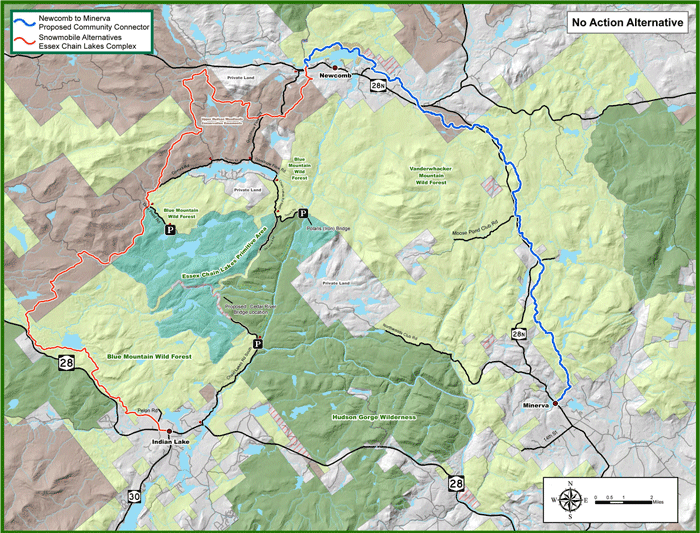
A perfectly viable, functional and enjoyable snowmobile trail system already links Indian Lake to Newcomb. In July, the APA approved construction, which has begun, of a new snowmobile trail from Newcomb to Minerva. Thus, Indian Lake and Minerva are already connected, making a new trail system from Indian Lake to Minerva redundant and unnecessary.
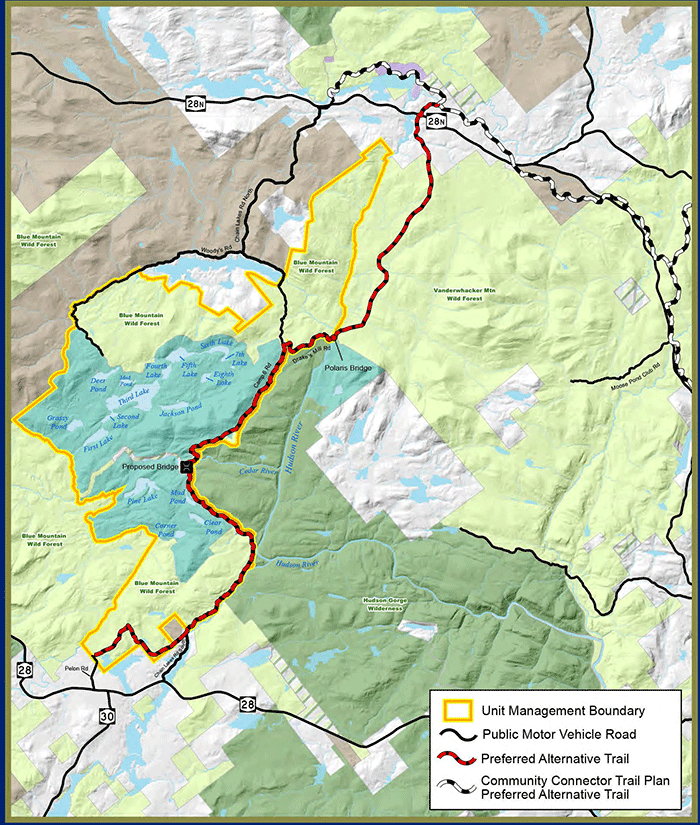
This map shows DEC’s favored alternative that seeks to build a new snowmobile trail through the Vanderwhacker Mountain Wild Forest area. Note that unlike the map above, the DEC does not show the existing Indian Lake to Newcomb snowmobile trail, which connects to Minerva. This is a new high for disingenuousness by the DEC.
The proposed actions to build a new Indian Lake-to-Minerva snowmobile trail in the ECCFUMP is also contrary to the priorities detailed in the 2006 Snowmobile Plan for the Adirondack Park. This plan contained a list of priority trail systems to link communities throughout the Adirondack Park. This plan is the definitive policy to date of vital community connection trails in the Adirondacks. Under “Community Connection Goals” in the “Trail Section” part of the Snowmobile Plan (pages 45-46), there is no mention of a Minerva-to-Indian Lake snowmobile trail. This was not a major goal for New York and was not recognized as a high priority. The Environmental Impact Study associated with the Snowmobile Plan did not evaluate the impacts of a Minerva-to-Indian Lake trail. PROTECT believes that in order for the APA-DEC to approve and build a Minerva-to-Indian Lake trail, the State must revise the 2006 Snowmobile Plan for the Adirondack Park.
Last, complaints have been made that part of the existing Indian Lake to Newcomb snowmobile trail in the Blue Mountain Wild Forest, a section paralleling NYS Route 30, is only a class I snowmobile trail, hence it does not allow for higher rates of speed or grooming with larger motor vehicles. The APA-DEC should investigate upgrading the existing trail from class I to class II in order to improve the existing Indian Lake-Newcomb-Minerva snowmobile trail route. Unfortunately, this practical, common-sense investigation was never undertaken.
Second, the proposed new class II community connector trail in the Vanderwhacker Mountain Wild Forest runs through Unit’s interior area. DEC’s plans to retain and utilize the Polaris bridge and build new class II community connector snowmobile trail through the interior of the Vanderwhacker Mountain Wild Forest area violates the Guidance because will be cut through a wild, interior area of the Forest Preserve. The western section of the Vanderwhacker Mountain Wild Forest has long been a trailless and wild part of the Forest Preserve and should remain so. The creation of this trail directly violates the Guidance.
Plans to Provide Motor Vehicle Use to Heart of the Essex Chain Complex Violates the SLMP: The Wild Forest corridor to 4th-5th Lakes on the Essex Chain violates the SLMP because it does not facilitate legal motor vehicle use. This road is an illegal peninsula into the Essex Chain Lakes Primitive area. The “tube” (culvert) that allows motor vehicle access across 4th-5th lakes should be removed and that channel ecologically restored. PROTECT supports access for the disabled under the CP3 program to the north shores of 4th-5th lakes with specially designed campsites and access points. Public motor vehicle access should end at the Deer Pond parking area.
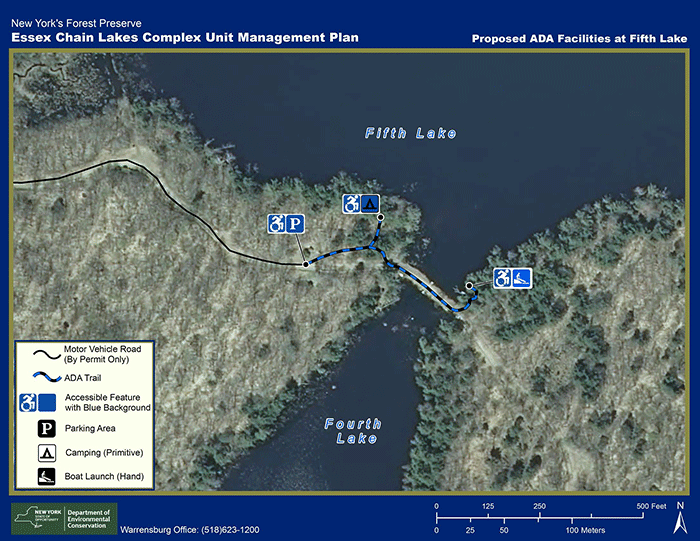
This picture shows the road between 4th-5th lakes on the Essex Chain Lakes. This road should be removed and the channel restored. Special access for the disabled should be facilitated on the north side of 4th or 5th Lake.
Plan Violates Past APA Precedent in UMPs: DEC’s plans for motor vehicle use within designated Wild and Scenic River corridors violates the Wild, Scenic and Recreational Rivers Act and violates long established management principles, practices, and precedents in long-standing Unit Management Plans, such as the Blue Mountain Wild Forest UMP. That UMP closed a snowmobile trail in a Wild River corridor, when these lands were purchased for the Forest Preserve. Contrary to the past precedent, the DEC is now seeking to allow motor vehicles within a Wild River corridor. The Blue Mountain Wild Forest UMP managed this situation correctly by banning motor vehicle uses within a Wild River corridor.
The proposed plan discards past precedent is a new and dangerous way.
Proposed Mountainbiking Plans require change to State Land Master Plan: The ECCFUMP proposes mountainbike use on a series of former logging roads that will be maintained as administrative roads or state truck trails. The most important issue is that mountainbiking is not allowed in a Primitive Area under the SLMP and the APA must revise the SLMP in order to allow this activity. Yet, in a move that’s never been done before, the DEC is asking the APA to approve a non-conforming use that will be made legal down the road with an amendment to the State Land Master Plan.
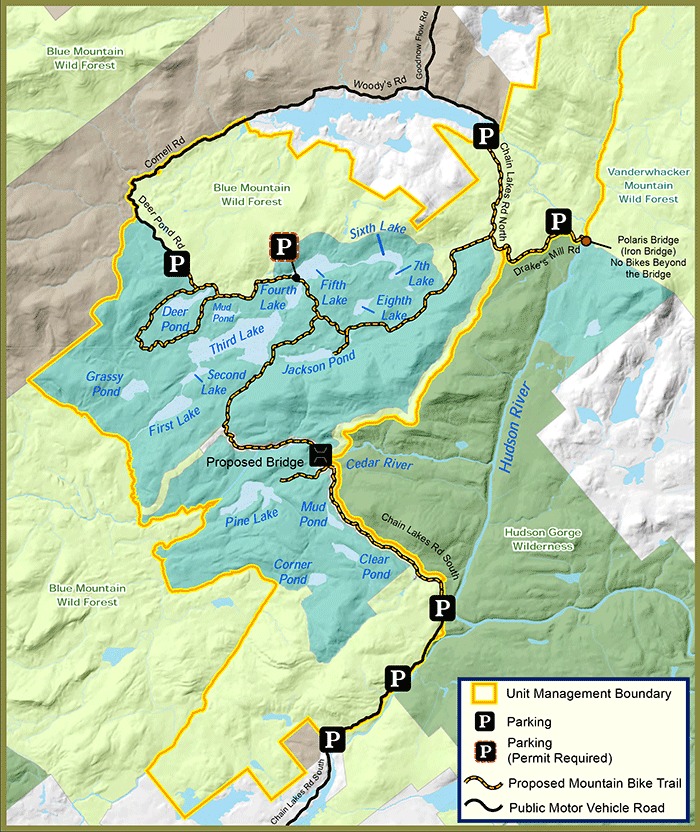
This map shows mountainbiking routes through the Essex Chain Lakes Primitive Area. Currently, the State Land Master Plan prohibits mountainbiking in Primitive Areas, yet the DEC-APA are seeking to approve mountainbiking in this area with then hopes of amending the State Land Master Plan at a later date. The APA has never before approved a UMP with controversial management options that require an amendment to the State Land Master Plan. This is bad public process.
PROTECT is dubious that there is a public interest for mountainbike riding on these dirt roads because there is so little mountainbike riding on the dirt roads of other Wild Forest areas in the Forest Preserve. There is not much riding in places like the Moose River Plains Wild Forest, other than race week of the Black Fly Challenge, or places like the Jessup River Wild Forest, Black River Wild Forest, or Ferris Lake Wild Forest. DEC should undertake market studies to determine feasibility, public interest, maintenance costs, and natural resource damage. There is no evidence that mountainbiking is desirable on roads anywhere else in the Forest Preserve. The success of the mountainbike system in the Wilmington Wild Forest also points to the popularity and public preference of specially designed, single-track trails and not dirt roads for mountainbike riding.
Class II Community Connector Snowmobile Trails Violate the State Constitution: The plan for a new class II community connector snowmobile trail to be cut through the Vanderwhacker Mountain Wild Forest area will violate the NYS Constitution because of the great number of trees to be cut and the vast alteration of the natural terrain which undermines constitutional protections that these lands be “forever kept as wild forest lands.”
Submit a Public Comment by October 16, 2015
The NYS APA is accepting public comments on the Essex Chain Complex final UMP. Please send your comments to:
Kathy Regan
Deputy Director for Planning
NYS Adirondack Park Agency
P.O. Box 99
Ray Brook, NY 12977
Fax: 518-891-3938
Email: SLMP_Comments@apa.ny.gov





